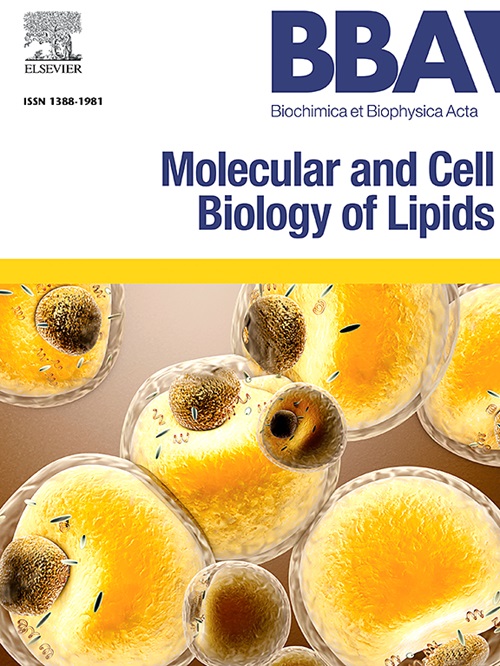单细胞转录组学分析和木犀草素治疗揭示了三个脂肪形成基因,包括Aspn, Htra1和Efemp1。
IF 3.9
2区 生物学
Q2 BIOCHEMISTRY & MOLECULAR BIOLOGY
Biochimica et biophysica acta. Molecular and cell biology of lipids
Pub Date : 2024-12-09
DOI:10.1016/j.bbalip.2024.159585
引用次数: 0
摘要
对肥胖小鼠和瘦小鼠脂肪干细胞和祖细胞(ASPCs)的转录组学比较分析可能有助于鉴定新的脂肪形成基因。在这里,我们通过分析三个独立的单细胞RNA测序数据集,比较了高脂饮食(HFD)和鼠粮(CD)喂养小鼠皮下脂肪组织(SAT)的ASPCs转录组学差异。在hfd喂养小鼠中鉴定并确认了6个差异基因,包括3个上调基因Aspn、Rrbp1、Fbln2和3个下调基因Htra1、Plpp3、Efemp1。此外,这些基因的表达被发现在分化的3 T3-L1细胞中显著减少。木犀草素是一种已知能抑制3 T3-L1脂肪生成的膳食类黄酮,用木犀草素治疗可以逆转Aspn、Htra1和Efemp1表达的下降。此外,下调Aspn、Htra1和Efemp1显著促进3 T3-L1脂肪形成。综上所述,这些基因不仅在肥胖小鼠和瘦小鼠的ASPCs中存在差异,而且是木犀草素治疗后可以上调的脂肪生成抑制基因。本文章由计算机程序翻译,如有差异,请以英文原文为准。

Single-cell transcriptomic analysis and luteolin treatment reveal three adipogenic genes, including Aspn, Htra1 and Efemp1
A comparative transcriptomic analysis in adipose stem and progenitor cells (ASPCs) between obese and lean mice might facilitate the identification of novel adipogenic genes. Here, we compare transcriptomic differences in the ASPCs of subcutaneous adipose tissue (SAT) between the mice fed on a high-fat-diet (HFD) and the chow diet (CD)-fed mice by analyzing three independent single-cell RNA sequencing datasets. Six differential genes, including three up-regulated genes Aspn, Rrbp1, Fbln2 and three down-regulated genes Htra1, Plpp3, Efemp1, are identified and confirmed in HFD-fed mice. Further, the expression of these genes is found to be significantly diminished in the differentiated 3T3-L1 cells. Treatment with luteolin, a dietary flavonoid known to inhibit 3T3-L1 adipogenesis, reverses the decreased expression of Aspn, Htra1 and Efemp1. Furthermore, knockdown of Aspn, Htra1 and Efemp1 significantly facilitates 3T3-L1 adipogenesis. Together, these genes not only are differential in ASPCs between obese and lean mice, but also are the adipogenic inhibitory genes that can be up-regulated by luteolin treatment.
求助全文
通过发布文献求助,成功后即可免费获取论文全文。
去求助
来源期刊
CiteScore
11.00
自引率
2.10%
发文量
109
审稿时长
53 days
期刊介绍:
BBA Molecular and Cell Biology of Lipids publishes papers on original research dealing with novel aspects of molecular genetics related to the lipidome, the biosynthesis of lipids, the role of lipids in cells and whole organisms, the regulation of lipid metabolism and function, and lipidomics in all organisms. Manuscripts should significantly advance the understanding of the molecular mechanisms underlying biological processes in which lipids are involved. Papers detailing novel methodology must report significant biochemical, molecular, or functional insight in the area of lipids.

 求助内容:
求助内容: 应助结果提醒方式:
应助结果提醒方式:


